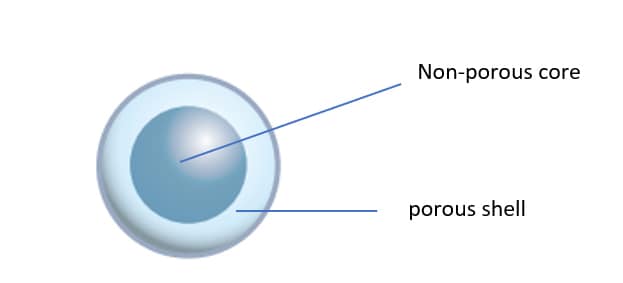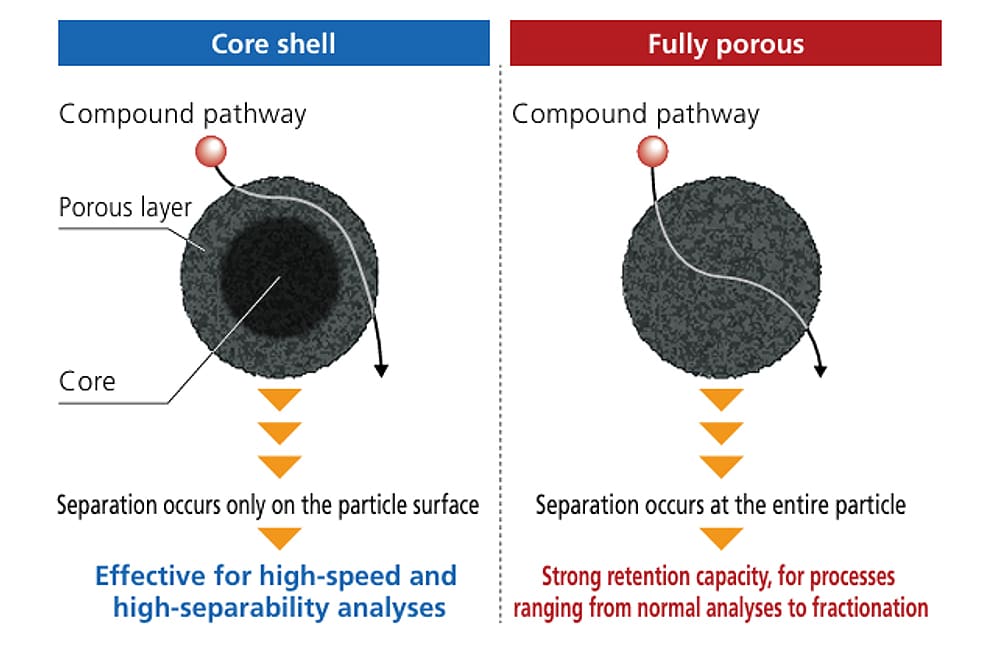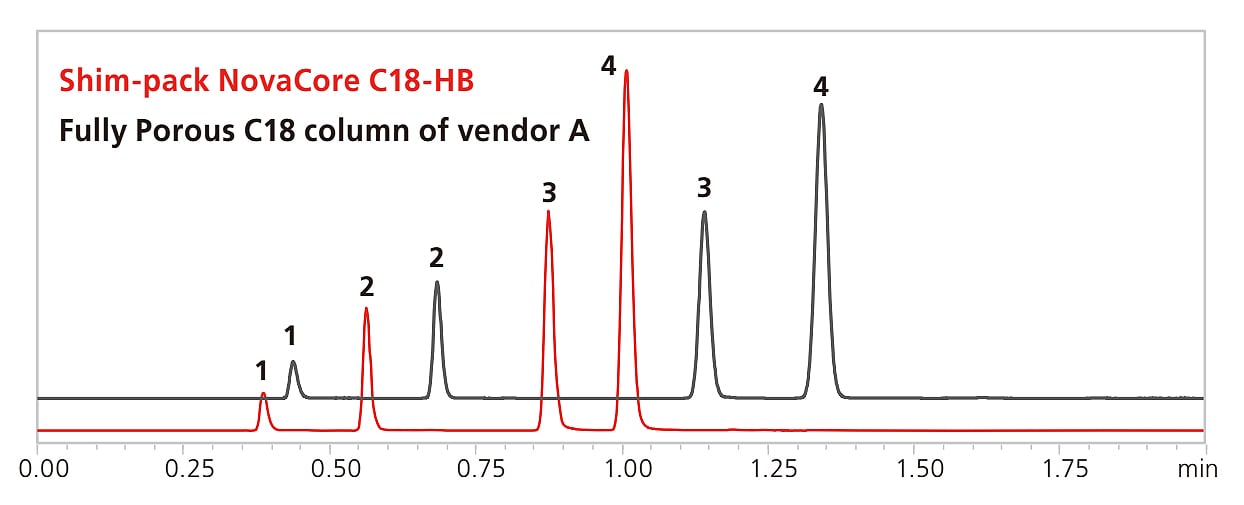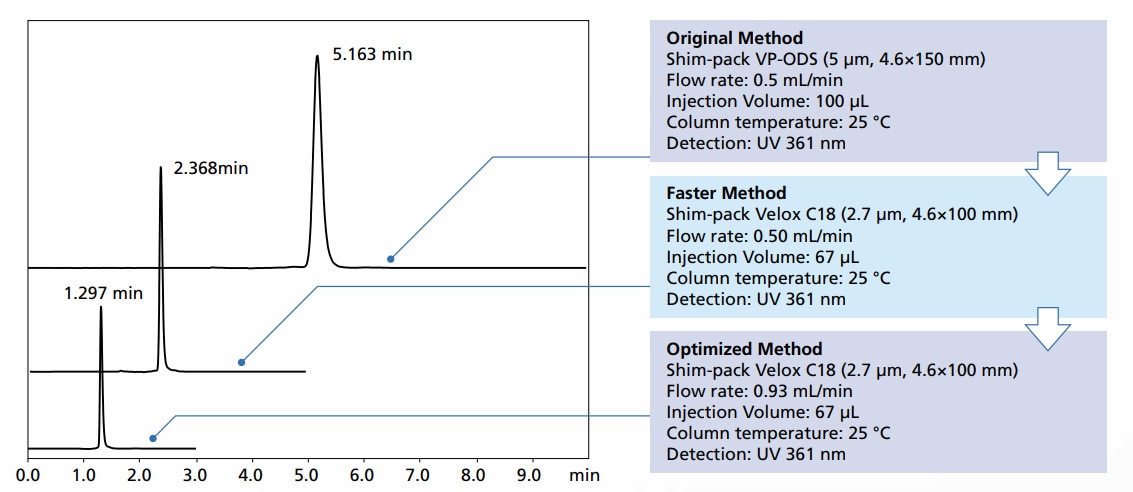Core-shell column
Core-shell particles consist of two parts: the core, which is a non-porous silica, and the shell, which is a porous silica gel layer chemically bonded to the core.

Fig.1 Structure of core-shell particle
The non-porous core enables the production of relatively uniform particles. Studies have shown that the particle size distribution is less than conventional fully porous particles. Furthermore, multiple uniform shell layers are added to create the porous layer, resulting in highly uniform particle sizes. As a result, core-shell particles exhibit a narrower particle size distribution compared to fully porous particles, delivering superior performance and reliable data.
Differences between core-shell and fully porous particles
The left side of Fig. 2 illustrates the movement of solutes within a core-shell silica particles. In this case, solutes diffuse exclusively through the porous shell, where they interact with functional groups. This streamlined diffusion pathway results in a faster mass transfer for solutes within the particle. Conversely, the right side of Fig. 2 depicts the movement of solutes within fully porous particles. Here, solutes penetrate deeper into the particle, reaching areas closer to the center (as shown in the schematic diagram). This more complex and extended pathway increases diffusion time, leading to broader peaks during analysis.
 Fig.2 Diagram of core-shell and fully porous characteristics
Fig.2 Diagram of core-shell and fully porous characteristicsFeatures of core-shell column
As discussed earlier, core-shell particles deliver the following chromatographic advantages due to their reduced mass transfer diffusion compared to fully porous particles:
Improved Peak Shape
Core-shell particles minimize solute diffusion within the column, enabling sharper and more defined peaks during analysis.
Reduced Column Backpressure
The porous structure of core-shell particles allows for a smaller pore volume through which the mobile phase flows, resulting in lower resistance and consequently reduced column backpressure.
Ideal for High-Speed Analysis
The core-shell structure facilitates faster solute diffusion within the porous layer compared to fully porous particles. This enables shorter analysis times, even under identical analytical conditions.
 Comparison of Shim-pack NovaCore C18-HB (Core-Shell Column) and
Comparison of Shim-pack NovaCore C18-HB (Core-Shell Column) andOther Companies' Fully Porous C18 Column
Example of Analysis Using Core Shell Columns
The quantitative analysis of cyanocobalamin (a synthetic form of vitamin B12) using a fully porous ODS column with a particle size of 5 μm was successfully transferred to a Shim-pack Velox C18 core-shell column with a particle size of 2.7 μm, while adhering to the method adjustment range specified in the United States Pharmacopeia (USP) General Chapter <621> Chromatography.
When using the Shim-pack VP-ODS fully porous column, the cyanocobalamin peak was observed at 5.163 minutes. In contrast, with the Shim-pack Velox C18 core-shell column under identical conditions, the cyanocobalamin peak eluted significantly faster, at 2.368 minutes. Further optimization of the flow rate within the adjustment range of the USP guidelines reduced the peak elution time even further, to 1.297 minutes.
This demonstrates that core-shell columns, such as the Shim-pack Velox C18, can significantly reduce analysis time and mobile phase solvent consumption, while offering improved efficiency in chromatographic workflows.

Shimadzu Core Shell Columns
Shimadzu provides two types of core-shell columns tailored for various applications:
Shim-pack NovaCore C18-HD
The Shim-pack NovaCore C18-HD is a unique core-shell column that utilizes an organosilica hybrid as its particle. This innovative design significantly enhances pH tolerance compared to conventional silica-based columns, enabling the use of basic mobile phases during method development. As a result, users benefit from greater flexibility and a broader range of options for their analytical needs.
Shim-pack Velox Series
The Shim-pack Velox Series features core-shell columns made from high-purity silica gel. While its pH durability is comparable to standard silica gel columns, the Shim-pack Velox Series delivers excellent cost performance. In addition to the C18 stationary phase, this series includes options with unique separation characteristics, such as Biphenyl and PFPP, to accommodate diverse analytical requirements.






